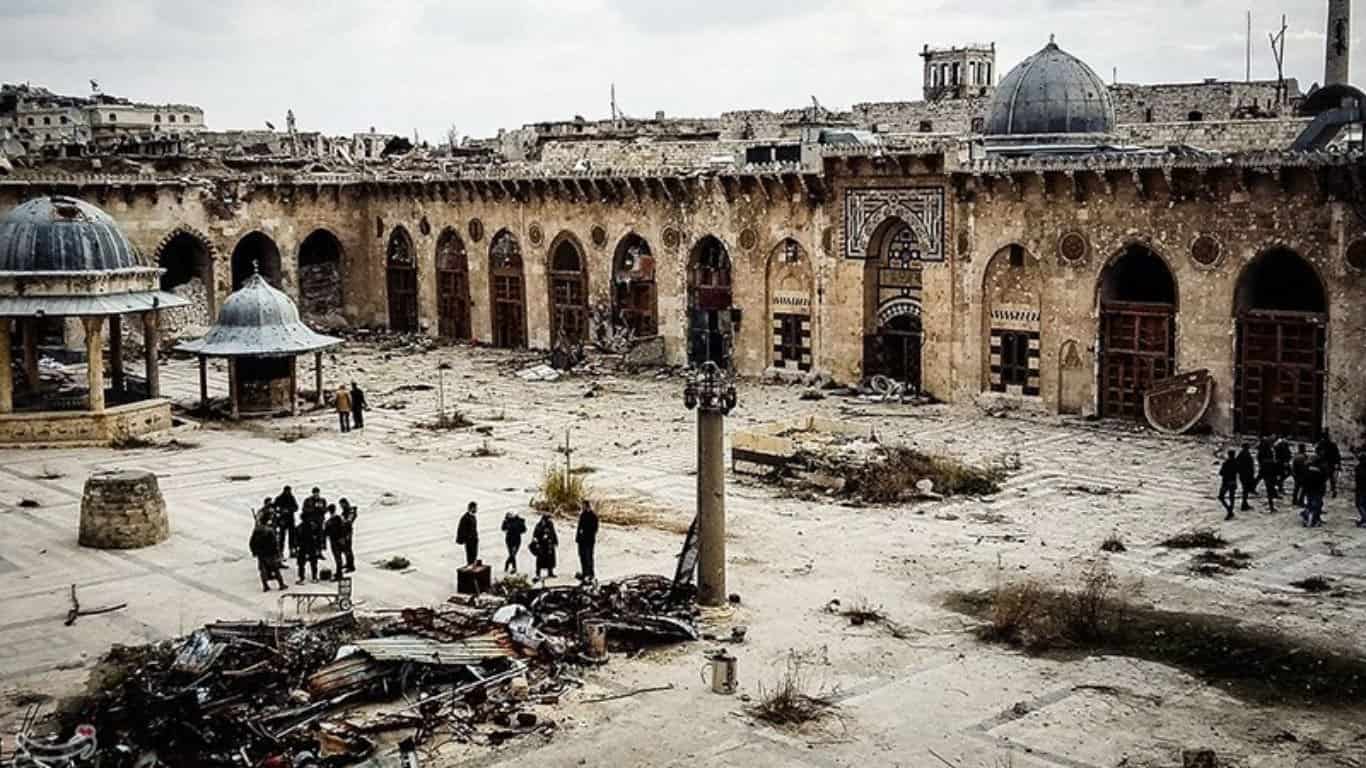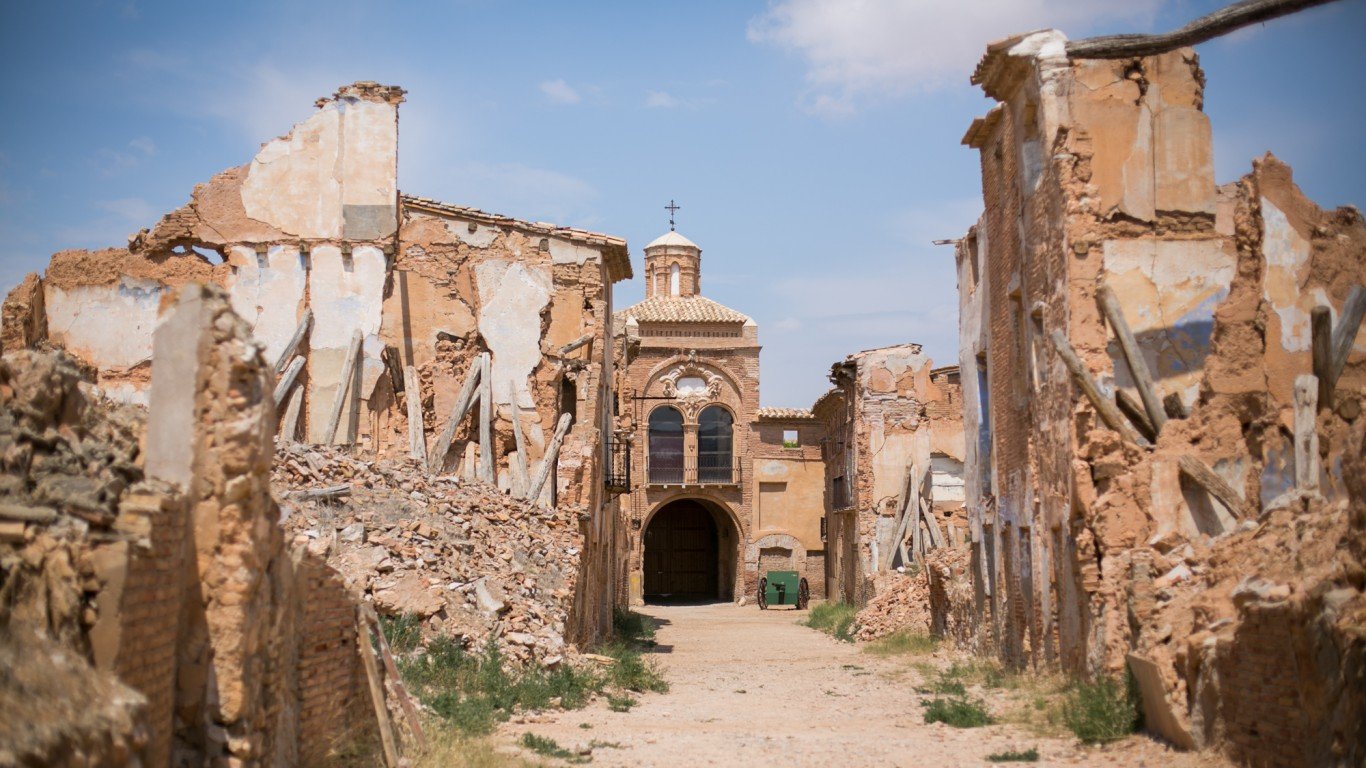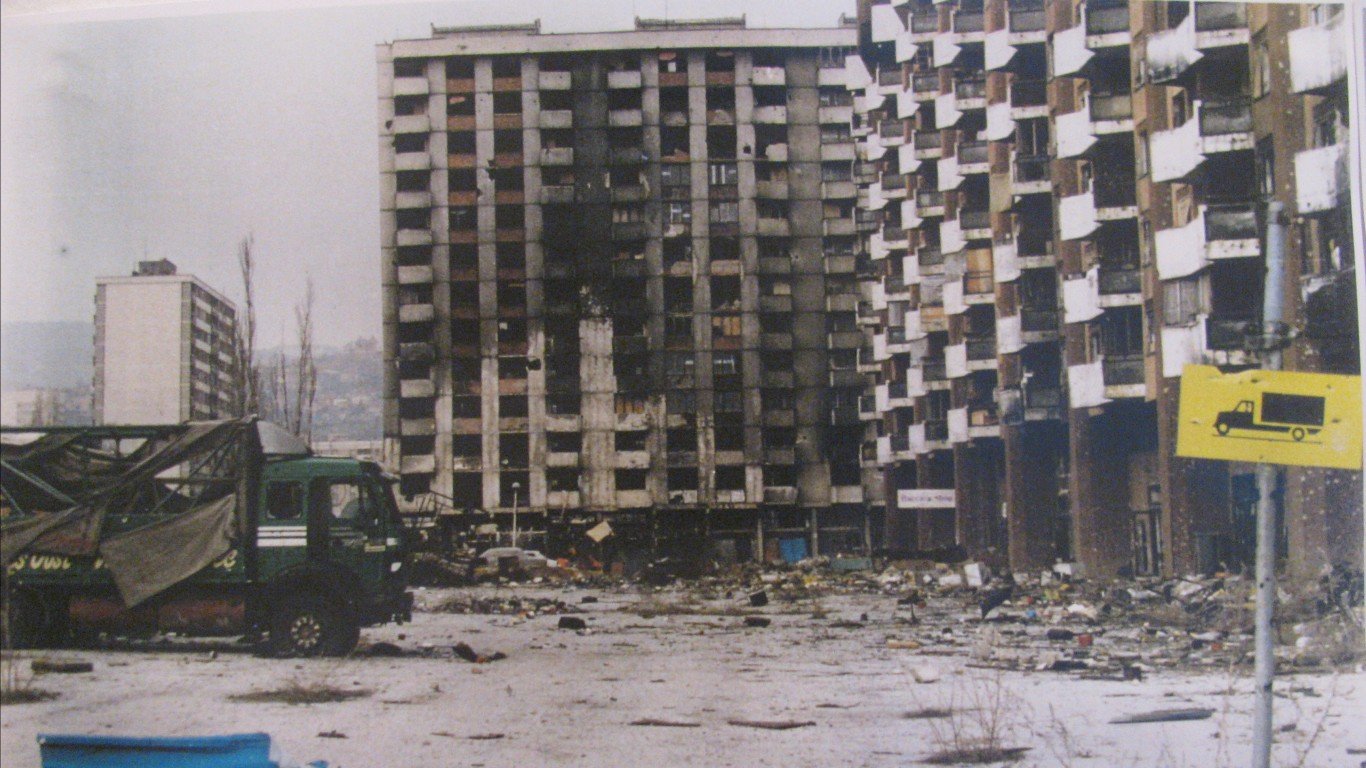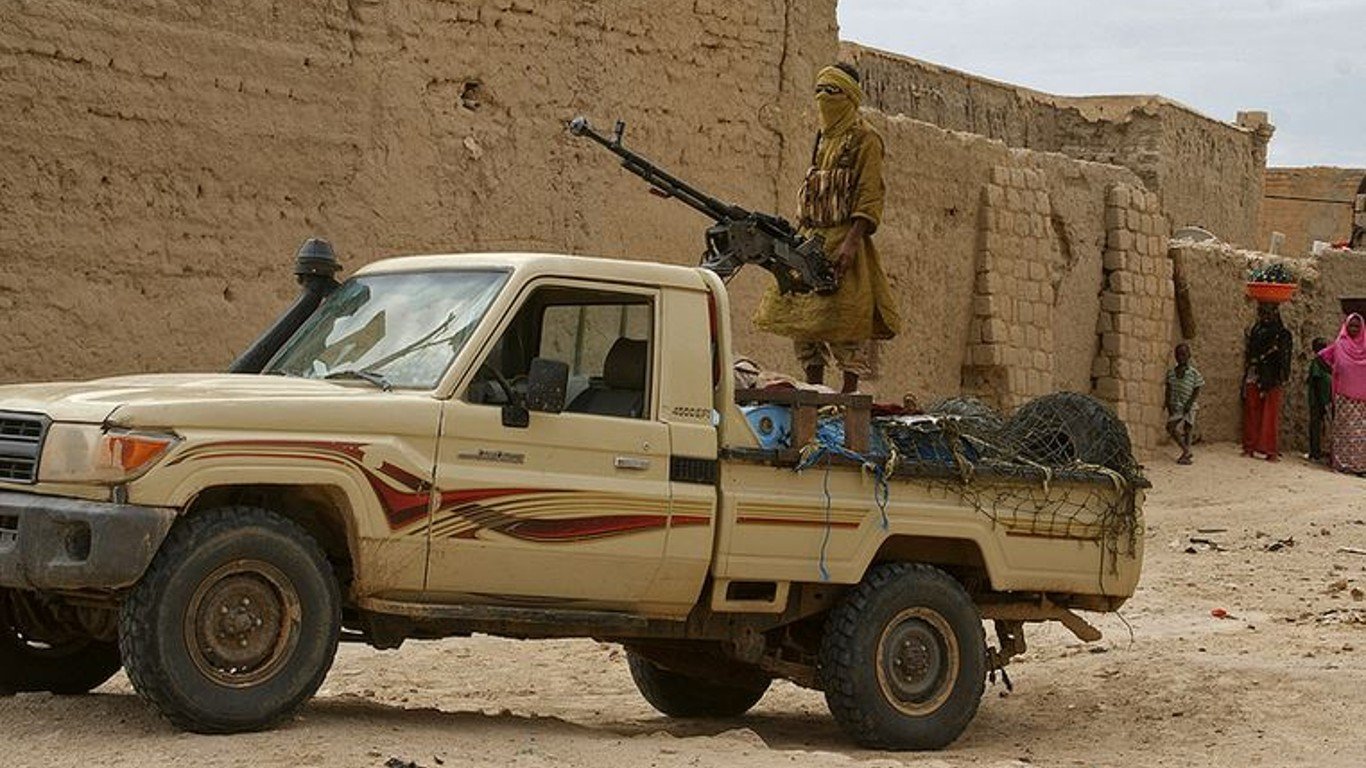According to the United Nations, the most destroyed city on Earth was Grozny, in the Republic of Chechnya, Russia. The capital of Chechnya was destroyed during two invasions by Russia, the first in 1995 and the second in 1999, in a fight over independence. This is just one of many cities on this list to have been destroyed by Russian invasion.
In early March of 2022, just a week into the Russian invasion of Ukraine, two towns in Ukraine’s eastern Donbas region – Volnovakha and Schastia – lay utterly destroyed after days of bombardment that targeted civilian infrastructure. By mid-April, bombs had destroyed 95% of the port city of Mariupol. Russian airstrikes, shelling, and missiles have also laid waste to hundreds of buildings and cultural sites in Kharkiv, Kyiv, Odesa, and many other cities and suburbs, leading to over 4,800 civilian casualties so far, and over 12 million displaced persons.
Common outcomes of war are civilian deaths, displacement, and damage to residential and commercial districts. Entire cities are sometimes annihilated as a side-effect of bombardment intended to destroy enemy infrastructure including railroads, ports, military bases, industrial centers, and government buildings. Other times, civilian areas are targeted intentionally as a tactic intended to damage morale, as in the U.S. atomic bombings of Hiroshima and Nagasaki – among the 17 cities destroyed by the U.S. in World War II.
24/7 Wall St. reviewed historical reports on cities that have been decimated by conflict, to determine the most war-damaged cities in history. Our research is restricted to the last 200 years. A disproportionate number of the cities on the list were destroyed during World War II, which marked the pinnacle of the age of aerial bombardment of populated areas. This list is not exhaustive. For example, the American campaign to firebomb Japan resulted in the burning of an average of 40% of the 60 major cities targeted.
Several cities were destroyed in a single day, while many faced months or years of siege, airstrikes, and fierce urban combat that slowly turned them to rubble. Cities known for their exquisite historic architecture, including Beirut, Dresden, and Ypres, were decimated by war. Others, like Mosul, Aleppo, and Timbuktu were home to irreplaceable ancient buildings and artifacts that have been burned, looted, or destroyed. (These are cultural treasures destroyed by war.)
Although ongoing conflicts in Syria, Iraq, and Afghanistan have prevented certain cities in these countries from rebuilding, and many of their residents are currently displaced, most bustling urban centers have been rebuilt. Some of these areas have also retained the same architectural style as the destroyed area – while a few smaller villages were left in ruins as war memorials.
Here are 26 cities destroyed by war in the last 200 years
1. Aleppo, Syria
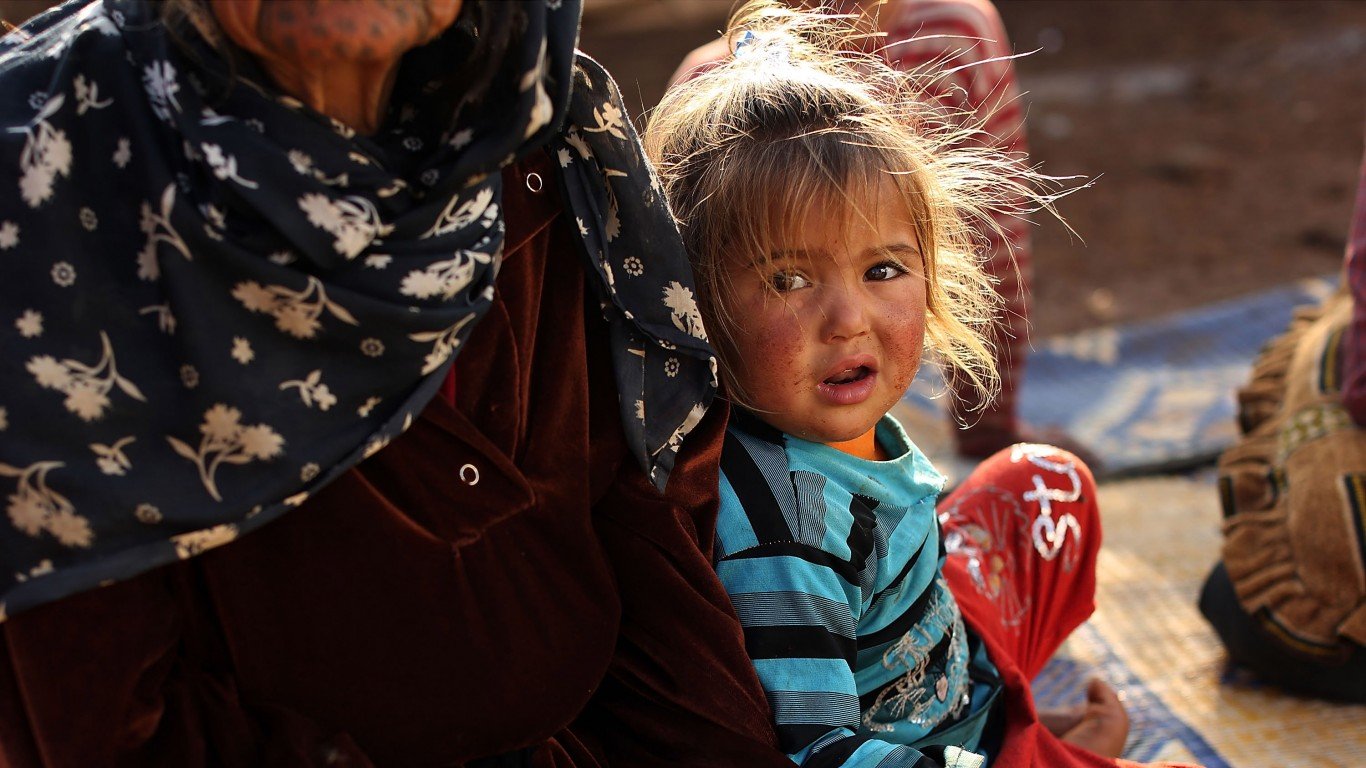
As part of the ongoing Syrian Civil War from 2012 through 2016, Aleppo – the country’s largest city – was a battleground, with a famed ancient citadel being used as a garrison for government troops. One of the oldest continuously inhabited cities in the world, Aleppo was home to two million people and countless cultural heritage sites that were damaged or destroyed in the fighting. Huge residential and commercial districts, especially in the rebel-occupied eastern half of the city, were also leveled.
2. Atlanta, Georgia, USA
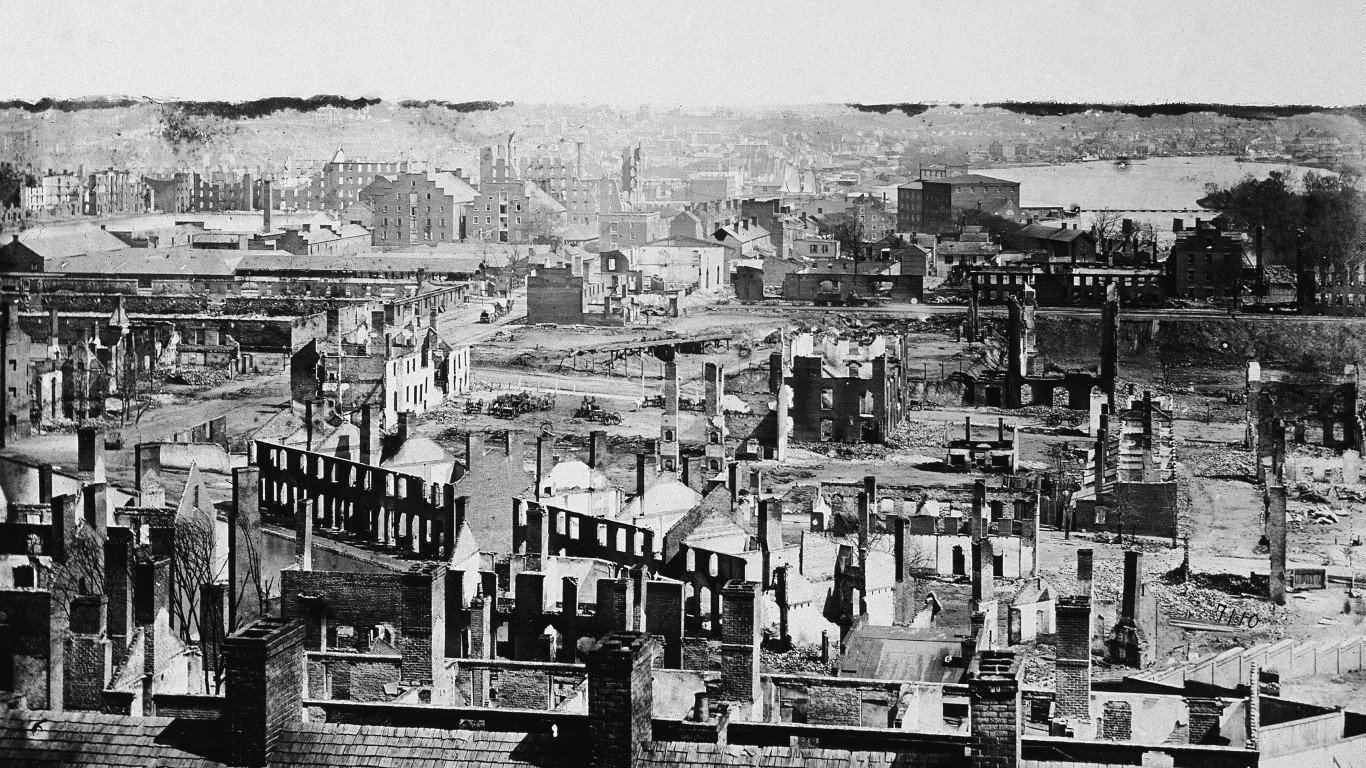
In November of 1864, under the command of General William Tecumseh Sherman, the Union Army embarked on an eastern march to overtake Confederate forces in Savannah, they burned the industrial center of Atlanta, obliterating railroad infrastructure crucial to the rebels. In all, 3,000 buildings were destroyed – possibly about 40 % of the city – along with the Confederate supply lines. After the war, it would take seven years to rebuild the decimated city.
3. Baghdad, Iraq
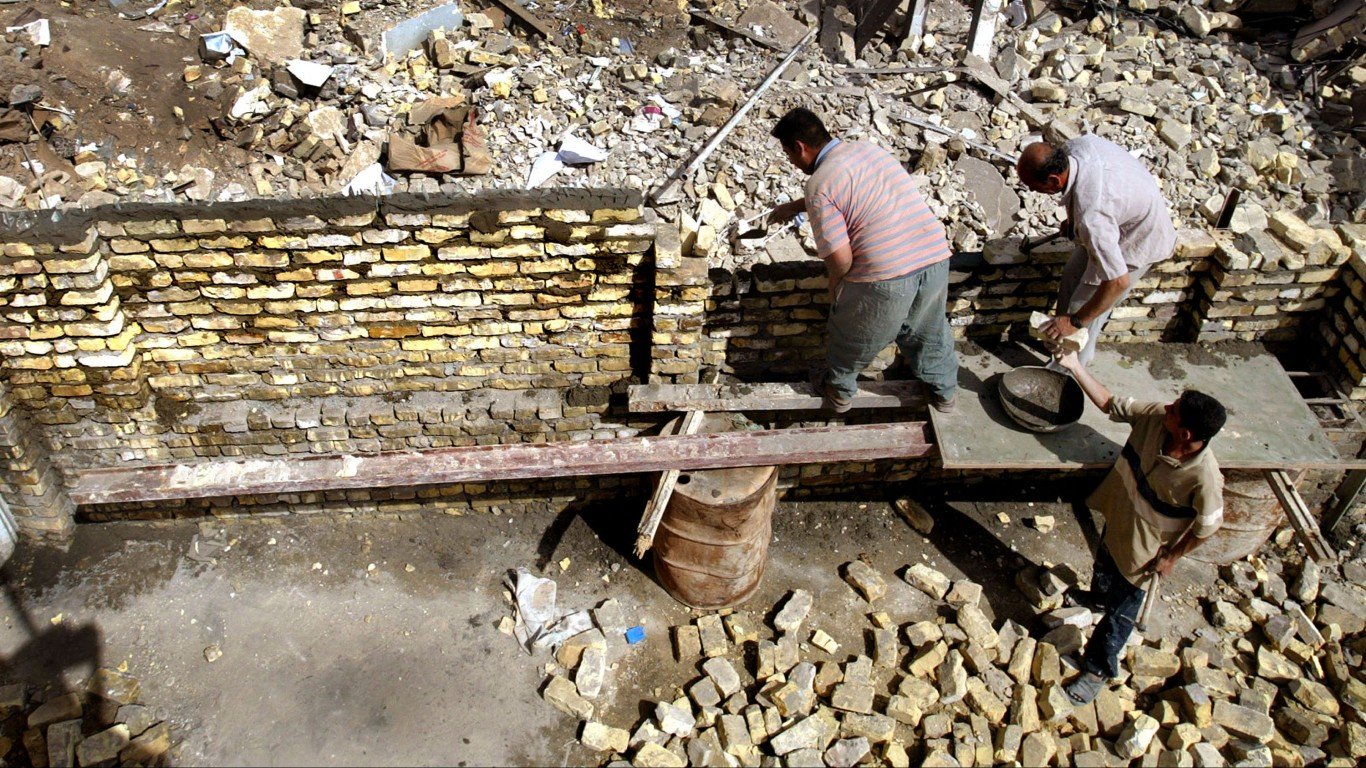
During the U.S.-led invasion of Iraq, which began in 2003, the capital city of Baghdad suffered extreme damage from aerial bombardment. In addition to government buildings, many residential areas were hit, leading to civilian casualties. During the ensuing years of insurgency, cultural sites – including the National Museum and National Library – as well as hospitals, bridges, and government buildings were looted, burned, and bombed by various armed groups engaging in ground combat.
4. Beirut, Lebanon
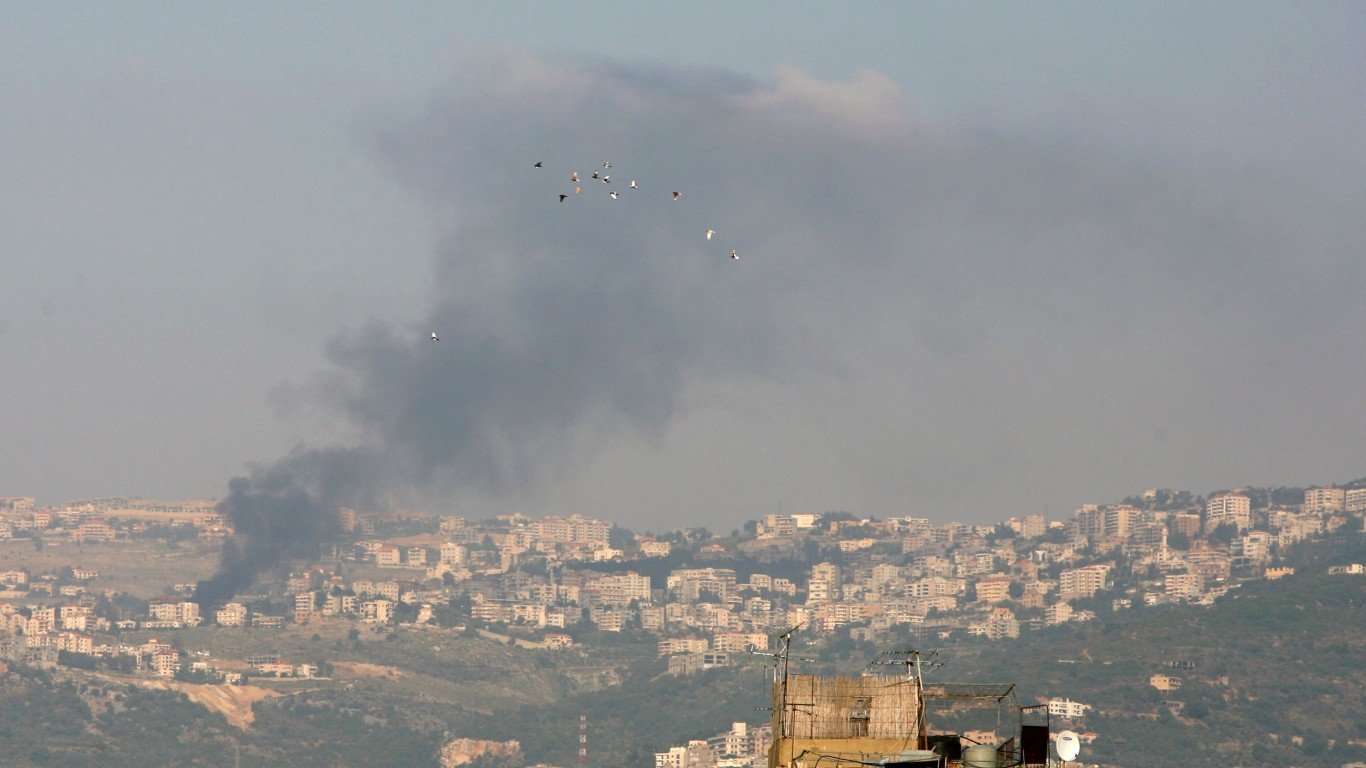
In the course of its history, Beirut has been occupied by numerous empires and has been destroyed and rebuilt seven times. Known for its Ottoman and French colonial architecture, the cosmopolitan city descended into ruin during the first two years of the Lebanese Civil War, beginning in 1975. Israel invaded in 1982, again leading to destruction, and Israeli bombardment in 2006 demolished many Shiite neighborhoods in the southern part of the city.
5. Belchite, Spain
A siege from Aug. 24 to Sep. 7 1937 during the Spanish Civil War destroyed the Old Town of Belchite in Aragon. When Nationalist forces retook the city in 1938, General Francisco Franco insisted that the ruins be left as a war memorial, and a new Belchite was built nearby. The rubble, containing a clock tower, a cathedral, and many crumbling residences, is open for guided tours.
6. Berlin, Germany
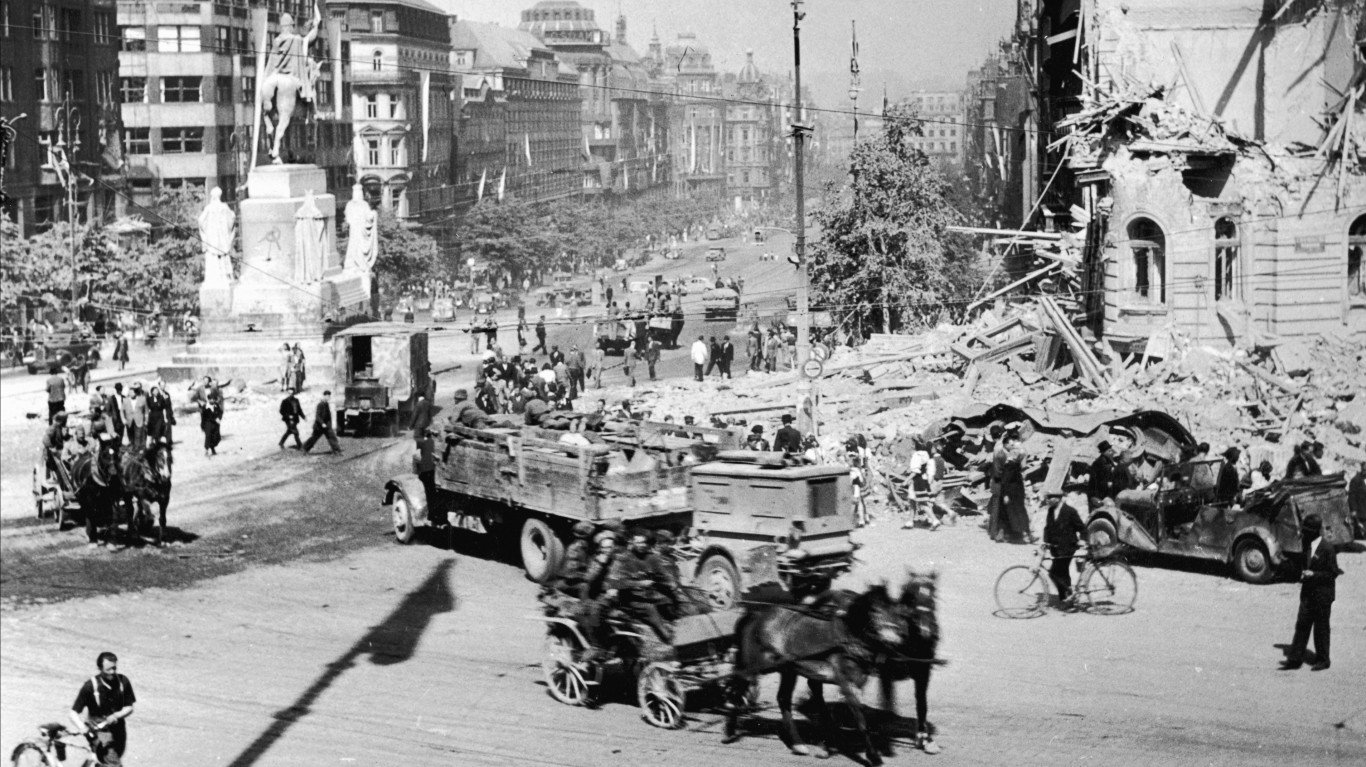
Throughout five years of extensive Allied bombing during World War II, the German capital was hit with over 67,000 tons of explosives. Hundreds of air raids combined with street battles destroyed about 80% of the city center. Fires raged for days at a time, churches and government buildings were gutted, hundreds of thousands of residences were destroyed, and underground railways were left exposed – and the damage was visible for decades afterward.
7. Dresden, Germany
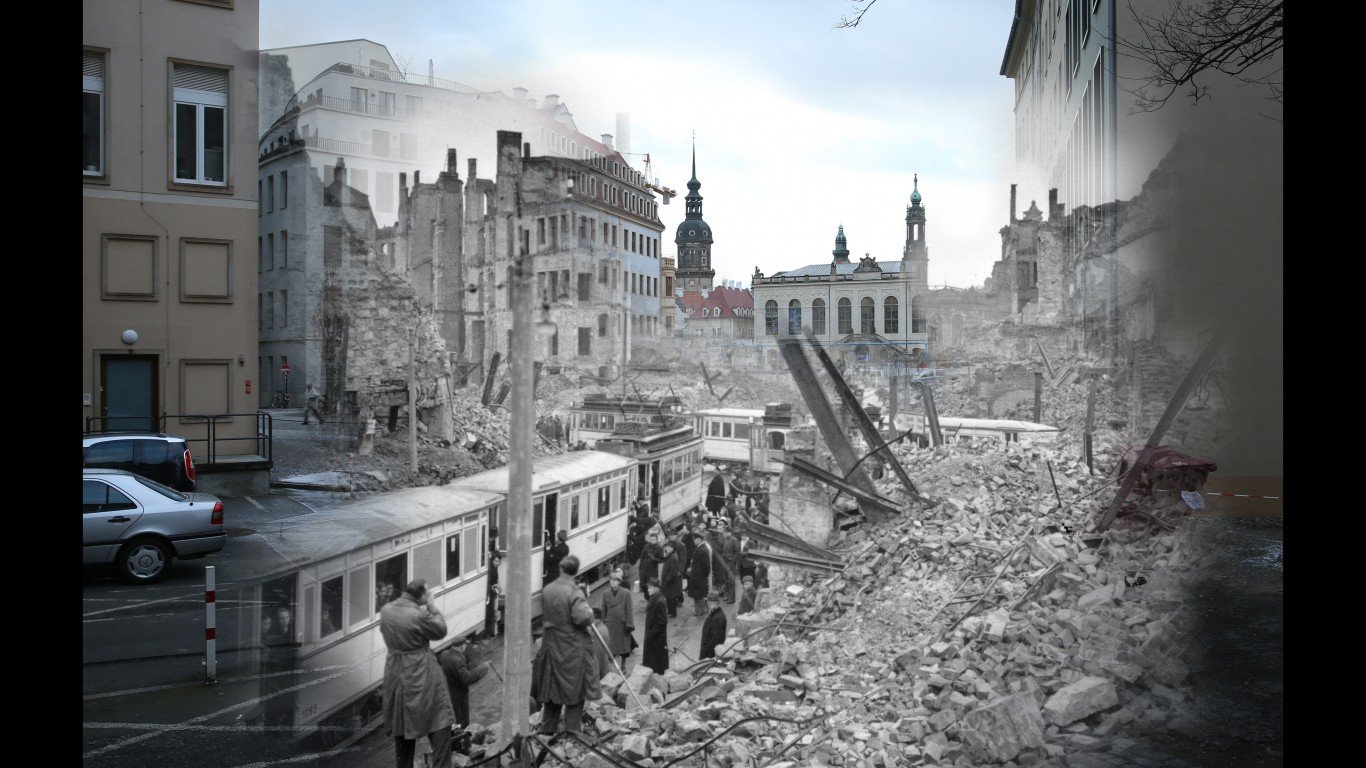
As the Germans were on the verge of surrender, on Feb. 13, 1945, British and U.S. forces began a series of aerial raids on the baroque city of Dresden. Its primarily wooden buildings were incinerated in the resulting firestorm, which reduced the city to rubble and killed 25,000 people. Previously known as the “Florence of the Elbe,” Dresden had been known for its fine architecture and museums.
8. Grozny, Chechnya
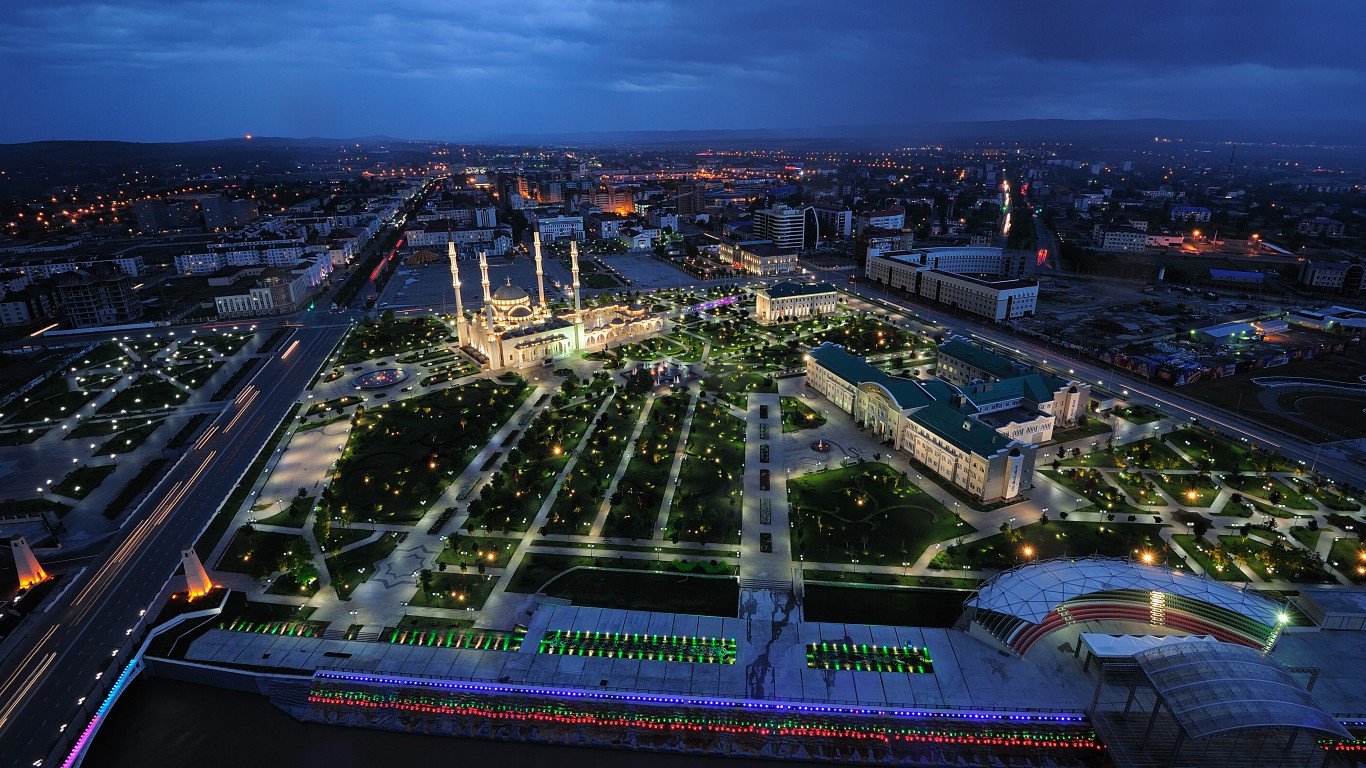
In a style of siege warfare that Vladimir Putin has subsequently utilized in Syria and Ukraine, the Russian military indiscriminately bombed the city of Grozny with long-range artillery, rocket launchers, tanks, warplanes, and ballistic missiles from Christmas of 1999 through early February of 2000. In what would come to be the bloodiest chapter of the Second Chechen War, up to 8,000 civilians were killed, and the United Nations declared the Chechen capital the most destroyed city on earth.
9. Hamburg, Germany

In July of 1943, Allied forces dropped over 9,000 tons of explosives on Hamburg, a large seaport and Germany’s most important industrial city. British and American bombers targeted not only shipyards and oil refineries but civilian infrastructure as well. During the first week of the bombing, a heatwave and winds contributed to firestorms that sucked all available oxygen from the air and destroyed over half of the city. Around 44,600 civilians perished.
10. Hiroshima, Japan
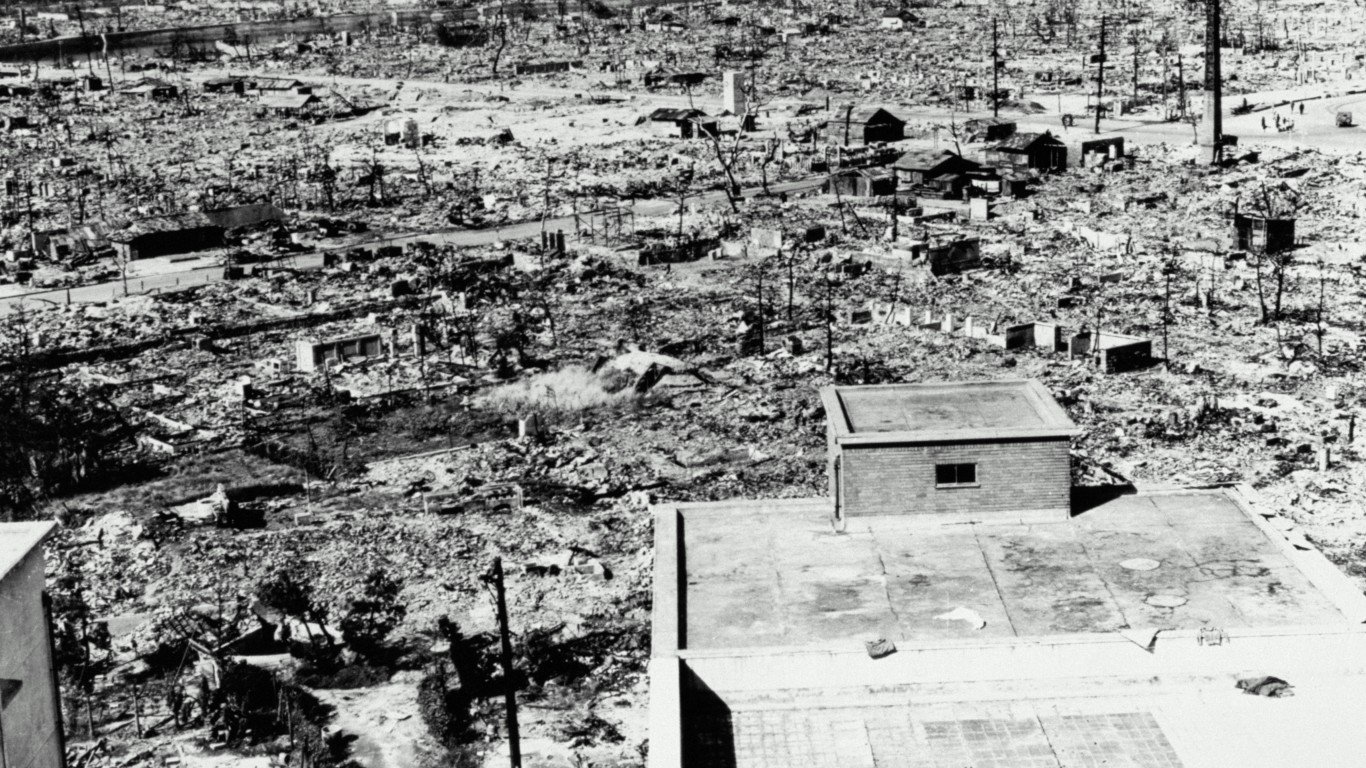
On August 6, 1945, an American B-29 bomber dropped an atomic bomb on Hiroshima, marking the first time a nuclear weapon had been utilized in war. Hiroshima was chosen in part because some of President Truman’s advisors believed that targeting an urban area for annihilation would break the will of Japan’s populace and end the war. The city, which had been spared from earlier bombing raids, was largely intact until the atomic bomb immediately killed 80,000 people and destroyed 60,000 buildings.
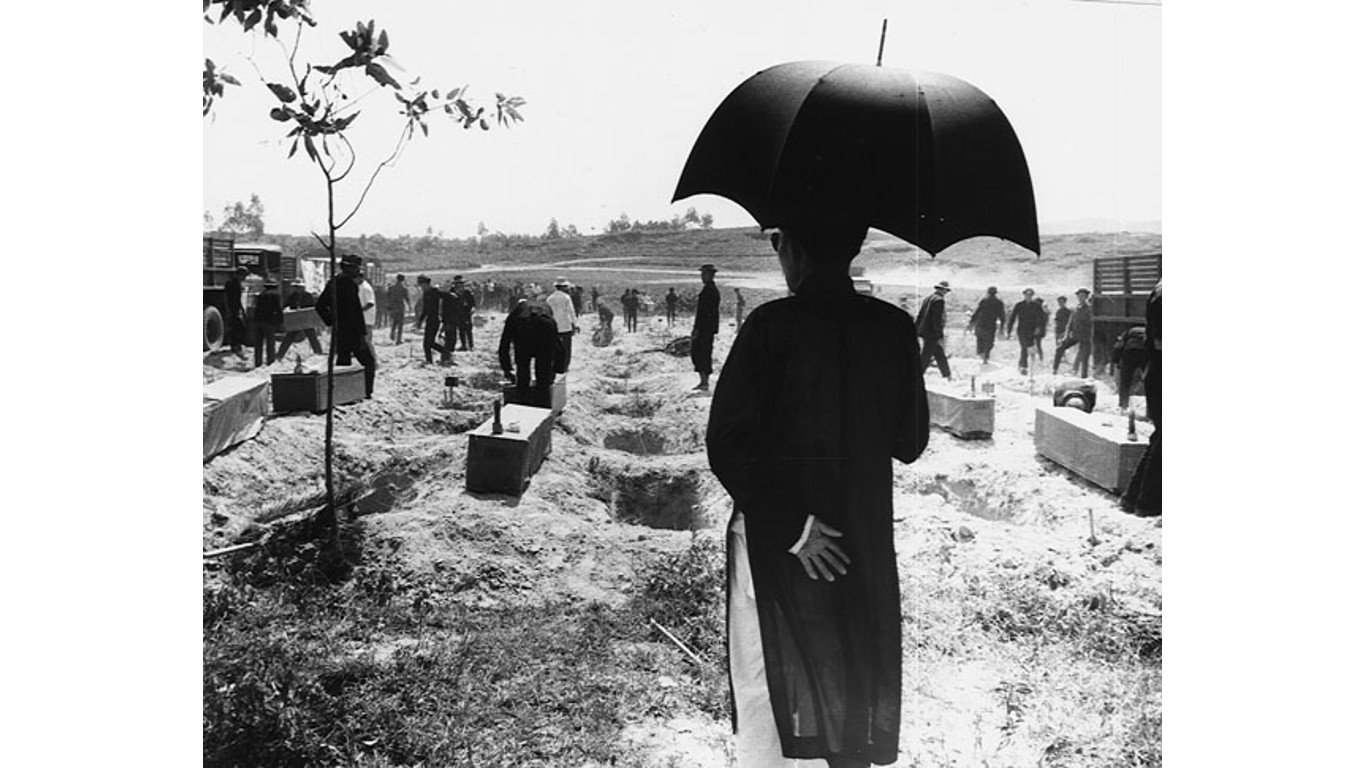
12. Hull, England
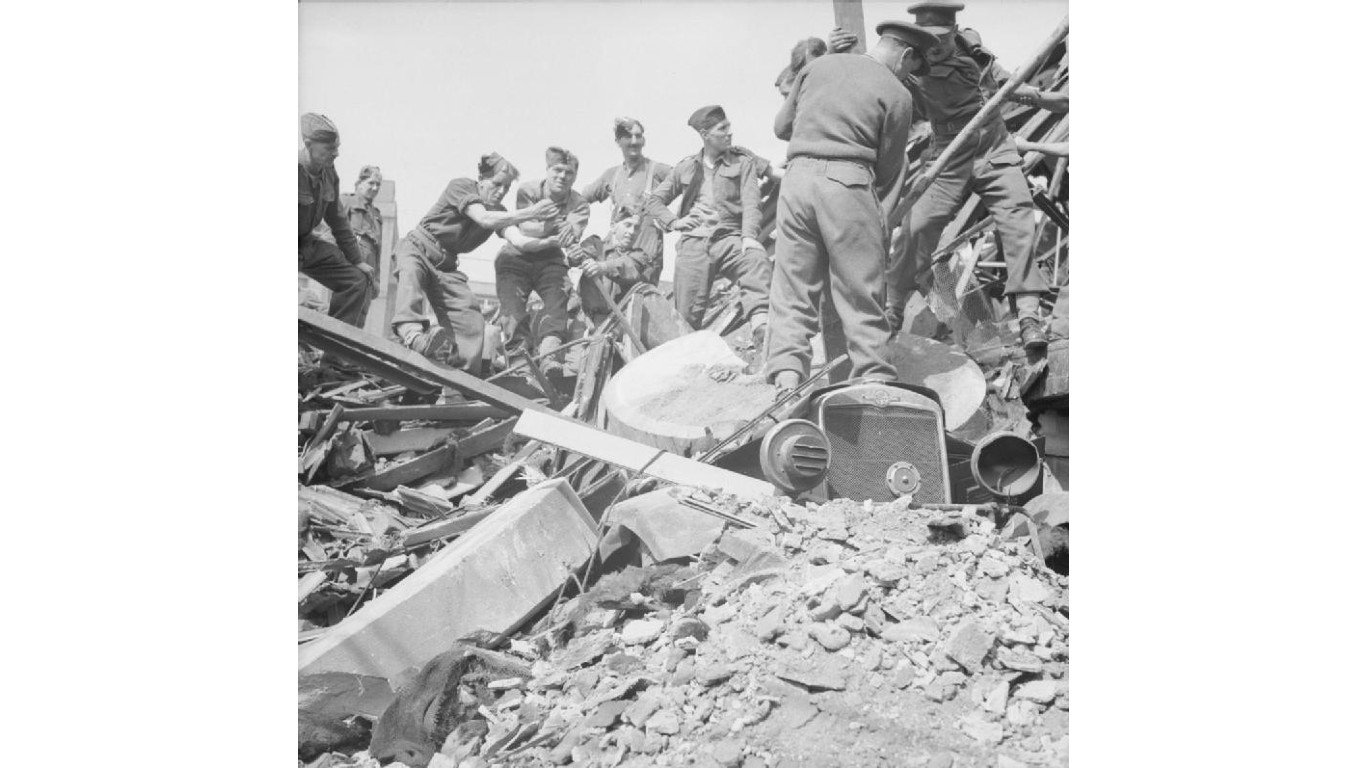
Germany blitzed the English port city of Kingston upon Hull in March of 1941, destroying or damaging 95 % of the city’s residences as well as industrial centers and dockyards. Although only 1,200 people were killed in the bombings, 152,000 became homeless and half of the city center was demolished.
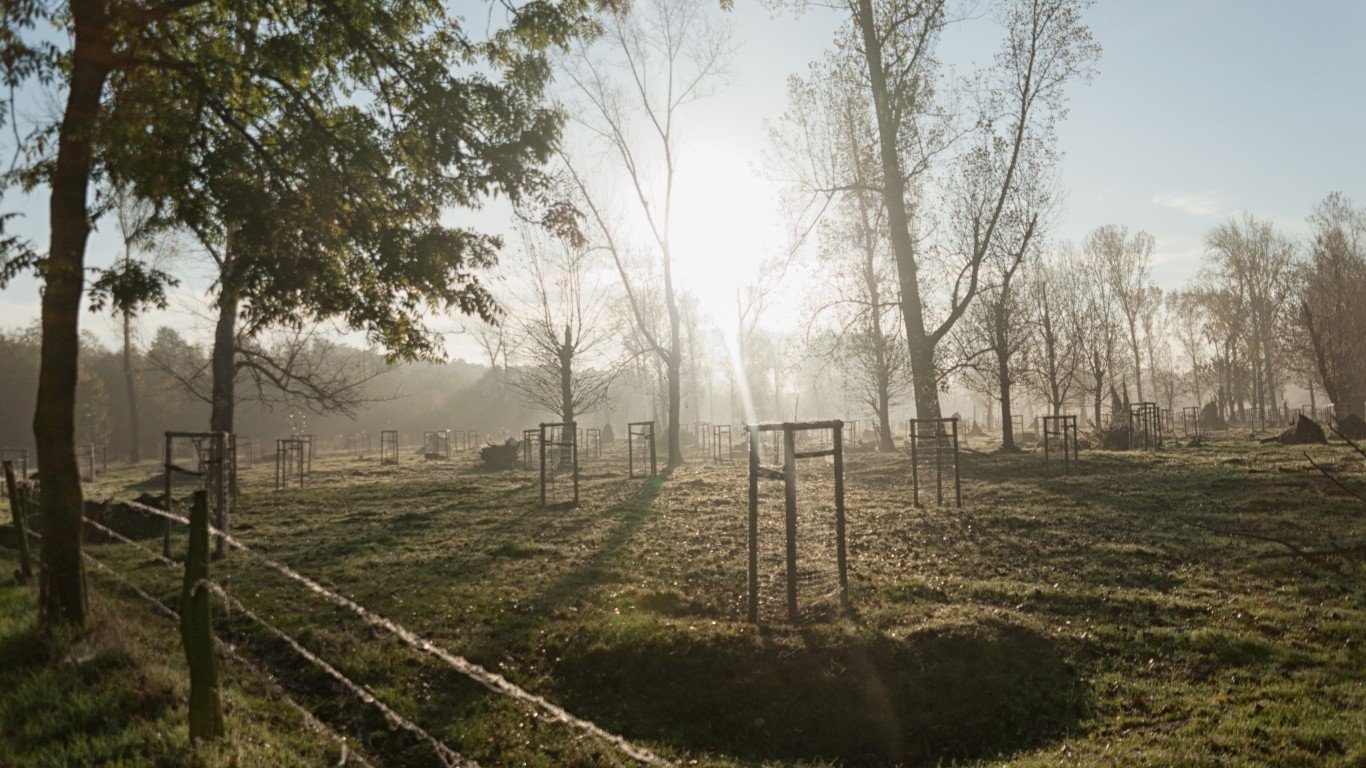
On November 16, 1944, Allied bombing destroyed 97% of the fortified medieval German city of Jülich as a crucial part of the Allies’ attempt to occupy the Rhineland. During the next few months, the remainder of the city was destroyed during heavy fighting in the area. Initial plans called for abandoning the ruins and rebuilding nearby, but Jülich was rebuilt onsite from 1949 to 1956 using a modified Renaissance plan of the city.
14. Kabul, Afghanistan
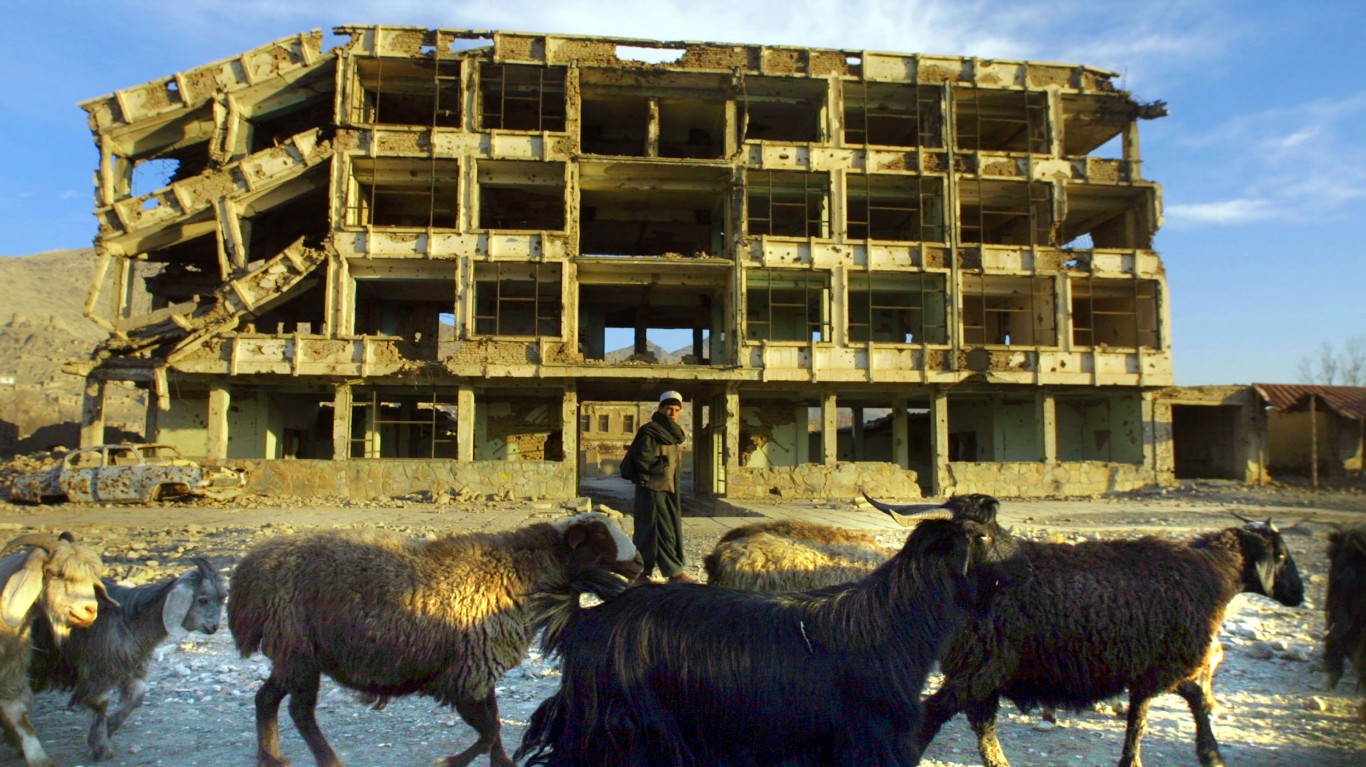
The capital of Afghanistan was once a peaceful, modern city in the ’50s and ’60s, but a Soviet-backed coup in 1978 began a period of war and unrest that continues to this day. Kabul was spared much of the fighting until a series of sieges and bombardments from 1992 until the Taliban took the city in 1996. Subsequent invasion by the U.S. added to the city’s ongoing battles.
15. London, England
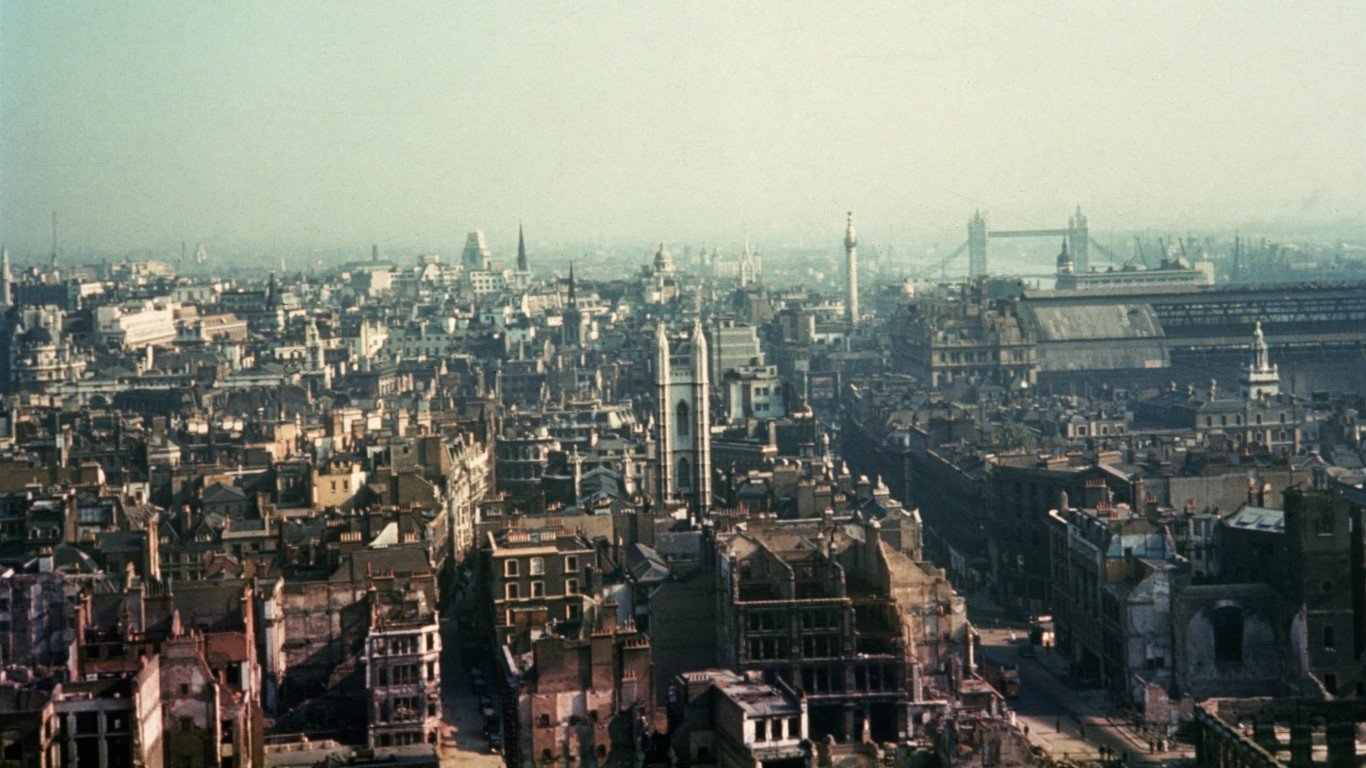
Between Sept. 7, 1940, and May 11, 1941, the German Luftwaffe bombed London and other strategic U.K. cities in a campaign that would come to be known as the Blitz. During the beginning of the air raids, the Nazis systematically bombed London every day for 57 days, destroying the historic center of the city. In all, over 28,000 London civilians were killed during the Blitz and another 25,000 were wounded.
16. Mosul, Iraq

The city of Mosul in northern Iraq was an ancient trading hub and is home to the second-largest antiquities museum in the country as well as dozens of historical and religious sites. Beginning in late 2016, a U.S.-led coalition demolished Mosul during nine months of intensive fighting and bombing to reclaim the city from the Islamic State. The historic Old City, the University of Mosul – including its library of three million books – and over 138,000 houses were destroyed. Civilian casualties are estimated at 11,000 but thousands of additional people remain missing.
17. Nagasaki, Japan
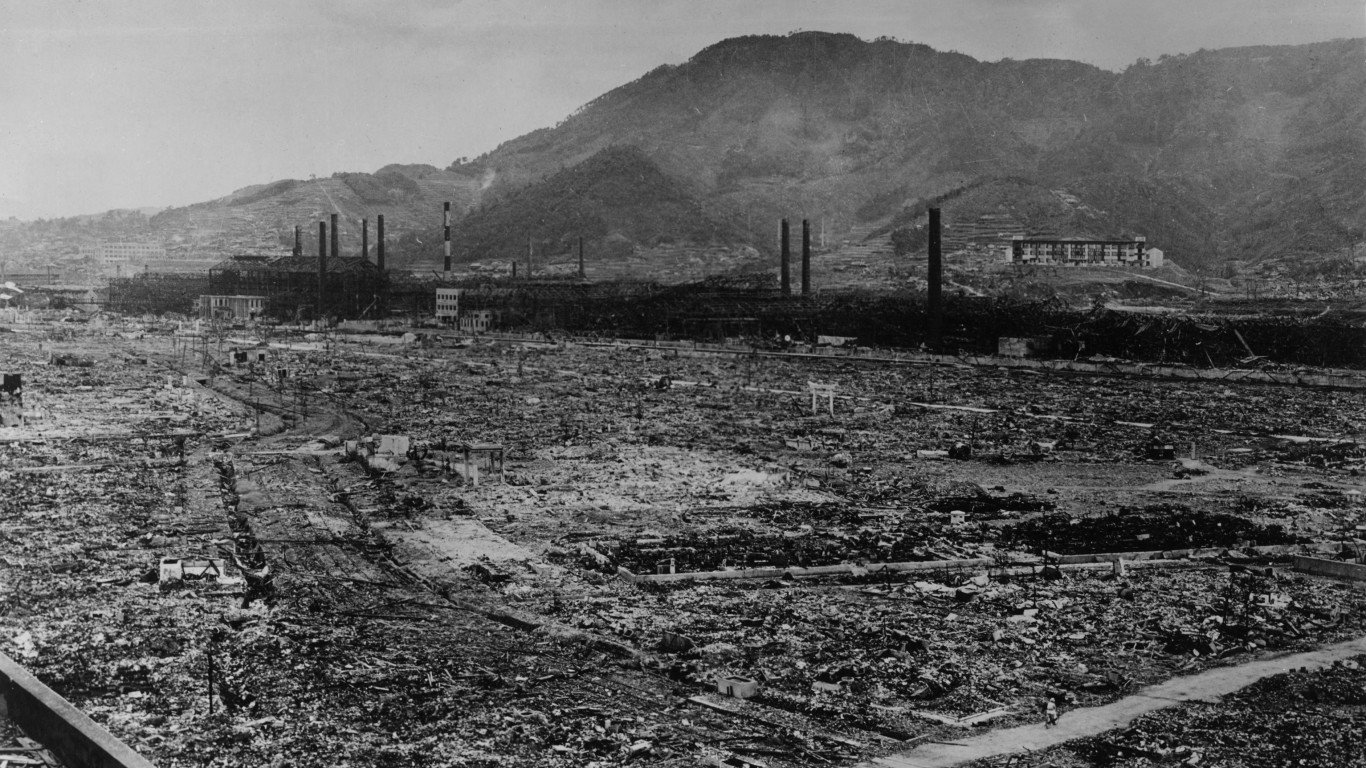
Nagasaki was a major Japanese shipbuilding center and the second U.S. atomic bomb target. Just three days after leveling Hiroshima, U.S. forces dropped an even more powerful bomb on Nagasaki, killing 40,000 people instantly, with another 40,000 dying later from radiation and injuries. Over 19,000 buildings were destroyed – which made up about 40% of the city.
18. Oradour-sur-Glane, France
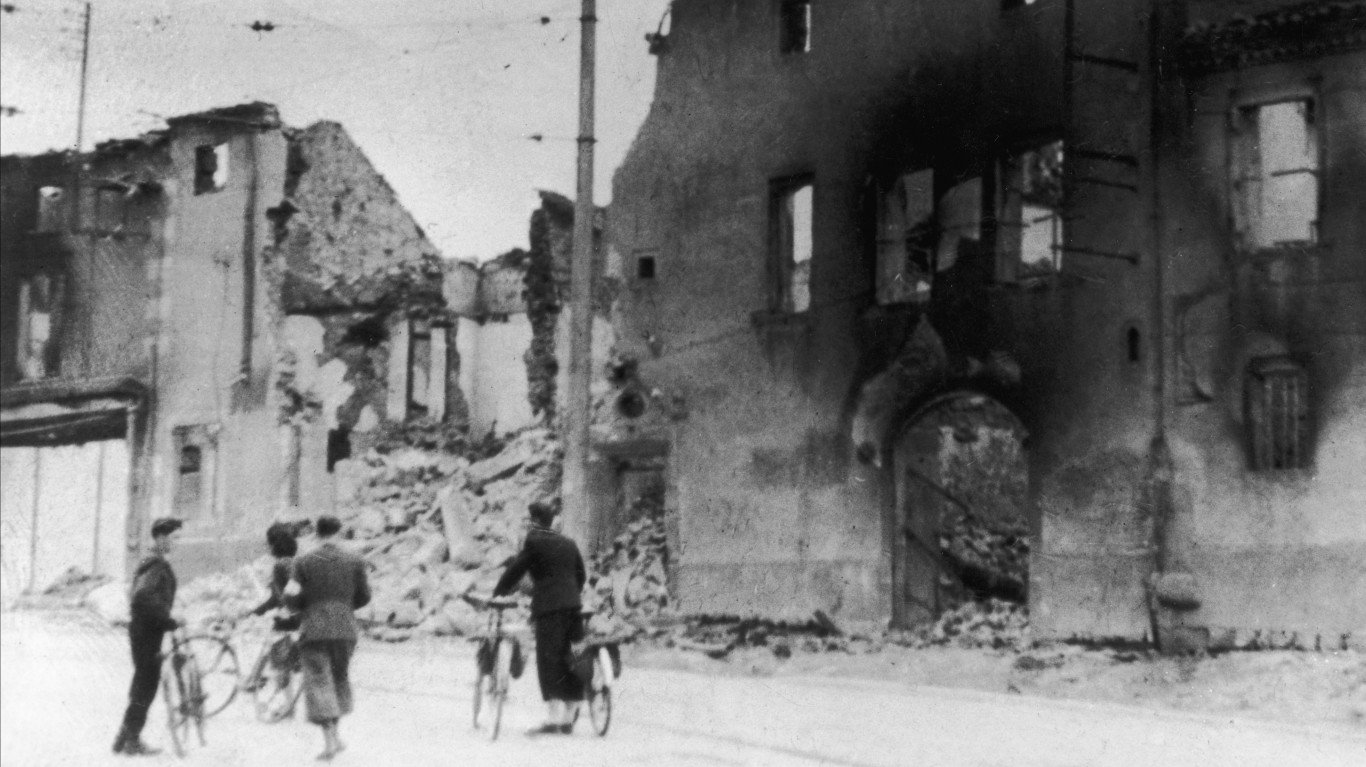
On June 10, 1944, Nazi troops massacred 642 civilians – nearly the entire population of this small, rural farming village in central France – and torched the buildings. After the war, the gutted ruins were left as a memorial, where they are still standing and open to visitors. A nearby museum contains household items and personal artifacts recovered from what is known as “the martyred village.”
19. Raqqa, Syria
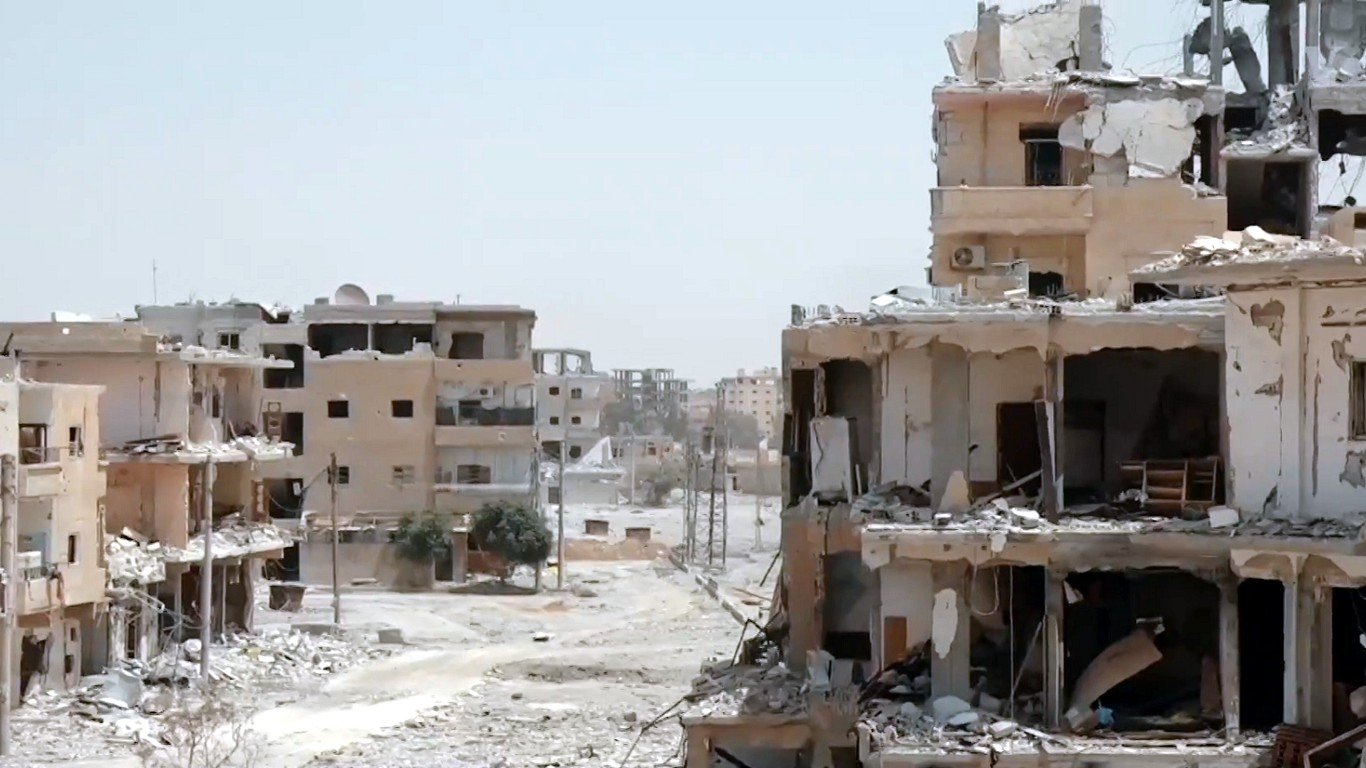
A U.S.-led coalition heavily bombed the Syrian city of Raqqa from June until October of 2017 in an effort to oust the Islamic State. Air and ground forces overtook the ISIL stronghold, but not without destroying 70% of the city, including residential areas, with an estimated 20,000 munitions. Raqqa, which was previously home to 200,000 people, was left 80% uninhabitable, according to the United Nations.
20. Sarajevo, Bosnia
The longest capital siege in modern warfare happened amid the Bosnian War (1992-1995), during the siege of the capital city, Sarajevo. As a result of extended shelling by the Bosnian Serb Army, 10,000 residences were destroyed, with another 100,000 damaged. In addition to hospitals and government buildings, irreplaceable cultural centers including the National Library were also demolished.
21. Stalingrad, Russia

German and Soviet forces engaged in the Battle of Stalingrad in the southwestern Soviet Union from August 1942 to February 1943. During the intense urban combat, which included not only airstrikes, artillery shelling, and tank assaults, but also fierce, close-quarters fire between troops sequestered in buildings, the city was reduced to a sea of fire and rubble. Axis forces were unsuccessful in their attempt to take Stalingrad but suffered hundreds of thousands of casualties.
22. Timbuktu, Mali
During the ongoing Mali War in 2012, 14 of 16 Islamic mausoleums that make up Timbuktu’s UNESCO World Heritage site were intentionally destroyed by the insurgent group Ansar Dine, as they claimed control of the city. In addition, the emblematic Al Farouk monument at the entrance to the city and over 4,000 sacred manuscripts were destroyed. A 2016 International court convicted an Ansar Dine leader for the destruction, ordering him to pay €2.7 million in reparations.
23. Tokyo, Japan

The single deadliest and most destructive air raid in history was the U.S. firebombing of Tokyo, known as Operation Meetinghouse, on March 9, 1945. Over 325 U.S. bombers targeted industrial centers – that were spread out among residential areas – with incendiary bombs and napalm that set off massive fire storms and wiped out 16 square miles of the city center, killing 100,000 civilians and leaving more than one million without homes.
24. Valletta, Malta
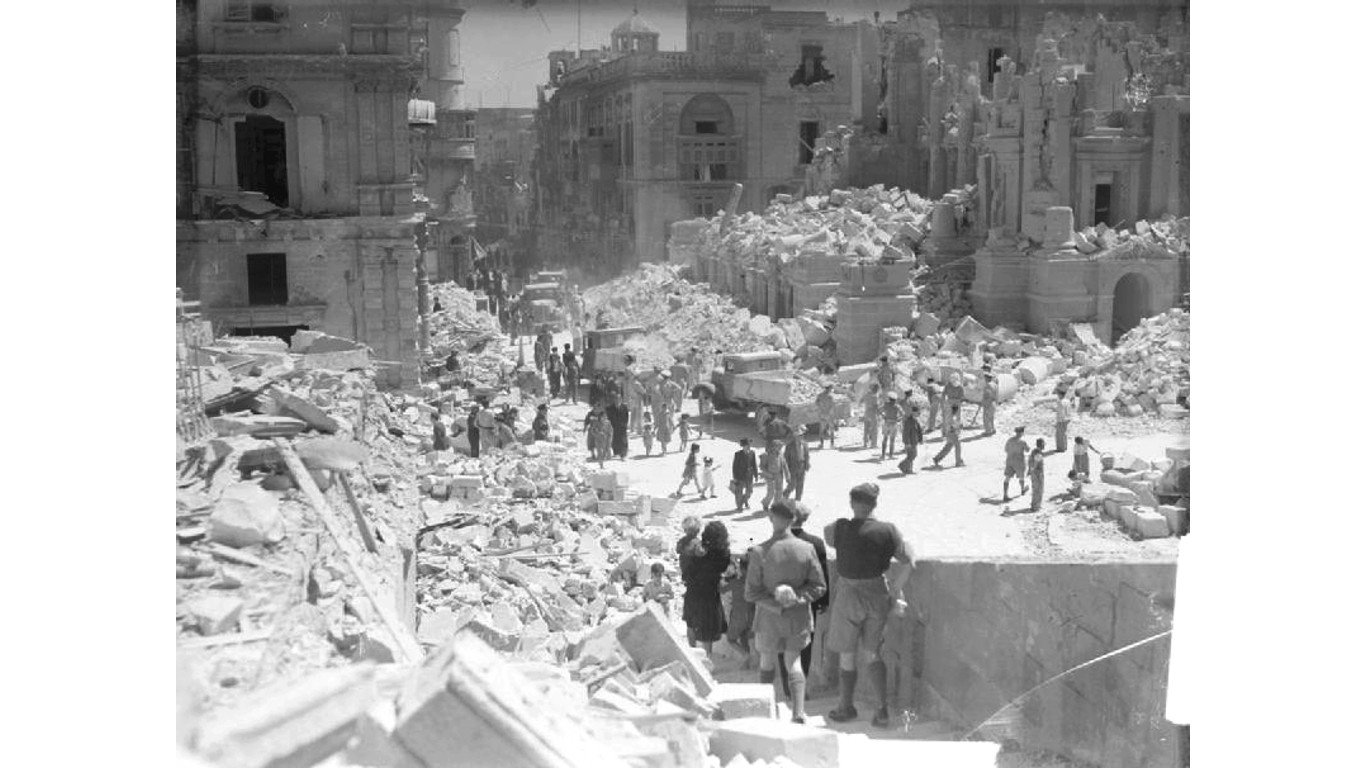
The capital of Malta and a strategic military center during WWII, Valletta was decimated during the siege of Malta, a battle between British forces and joint German and Italian forces. The walled city of 16th-century buildings was known for its exquisite architecture, much of which was destroyed by German aerial attacks. Among the other losses was a famed 19th-century Royal Opera House.
25. Warsaw, Poland
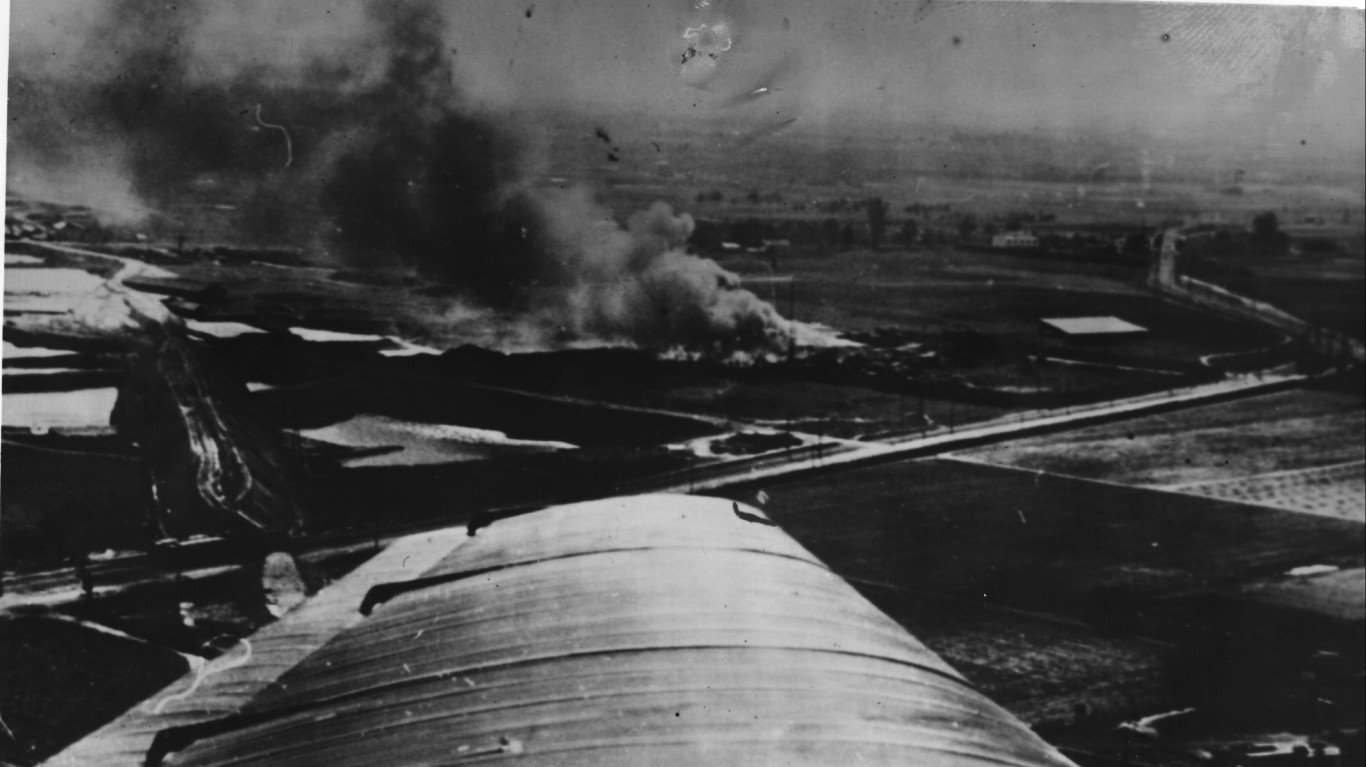
Although a 1939 Luftwaffe air assault on Warsaw demolished 10% of the city, the 1944 Warsaw Uprising saw another 85 to 90% of its buildings destroyed by German bombardment after Adolf Hitler ordered that the city be razed to the ground. After the war, the Poles meticulously rebuilt the historic Old Town exactly as it had been, using many of the bricks from the rubble.
26. Ypres, Belgium

Occupied by British and French forces, the medieval city of Ypres saw numerous battles during the four years of WWI. It was repeatedly attacked by German forces, who never succeeded in conquering the city, but did succeed in virtually flattening the entire town center. In the ten years after the war ended, Ypres was completely rebuilt, retaining its Flemish, medieval, and Renaissance architecture.
